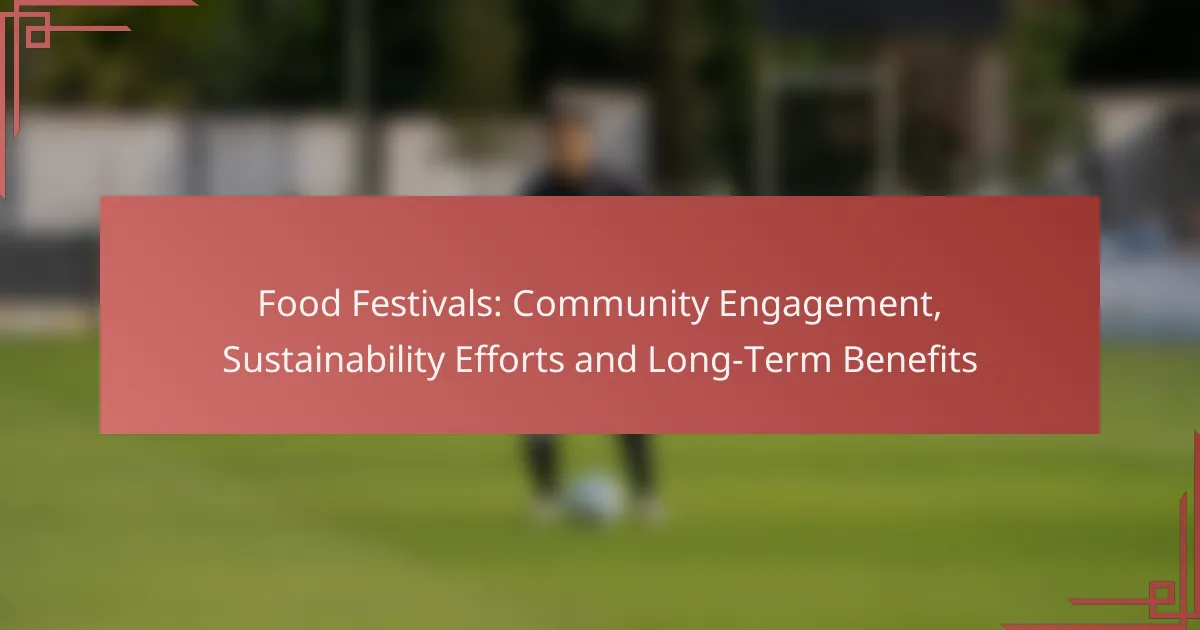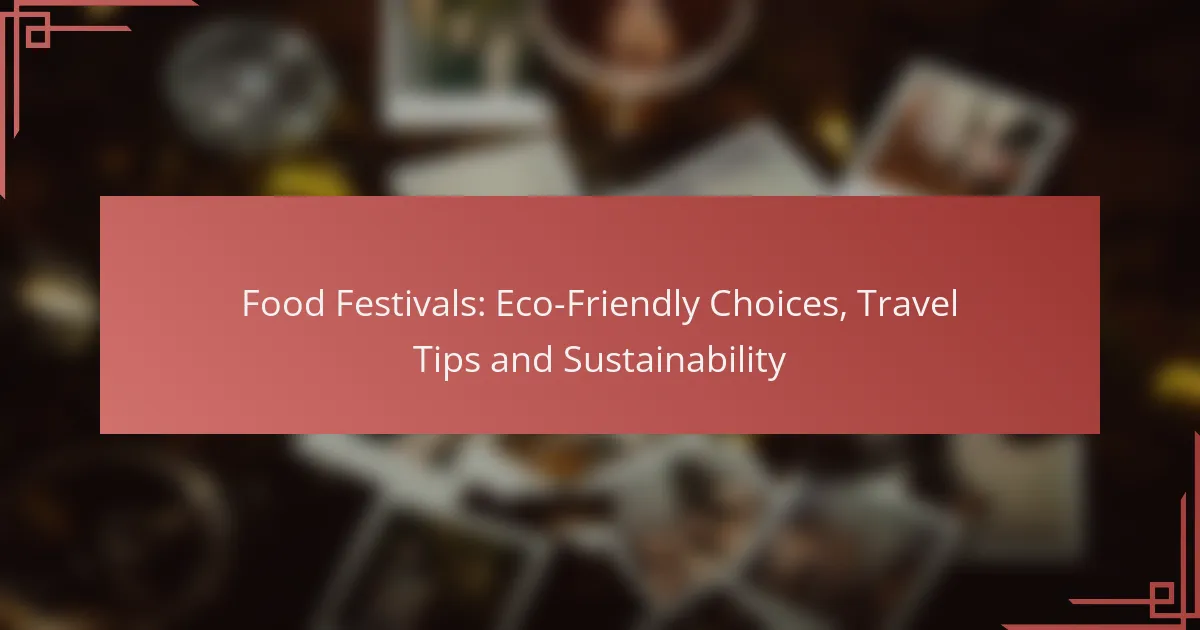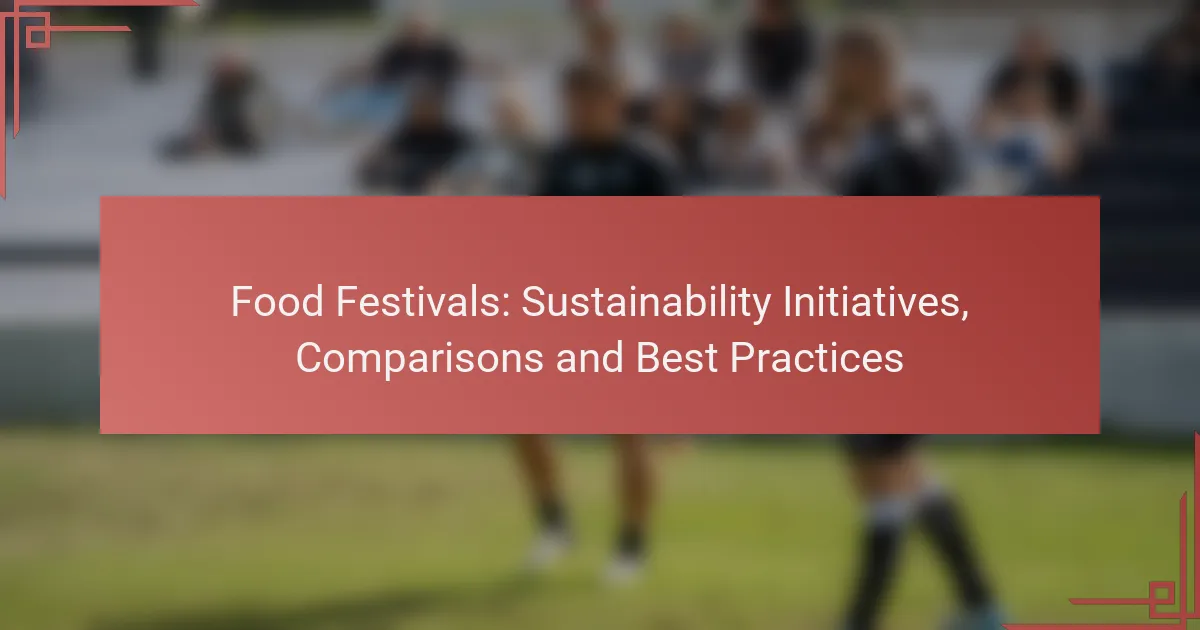Food festivals serve as a vital catalyst for sustainability and community engagement, promoting local sourcing and reducing waste while raising awareness about environmental practices. By fostering connections among residents, businesses, and organizations, these events not only enhance community pride but also support local economies and create lasting relationships that benefit the culture and environment.
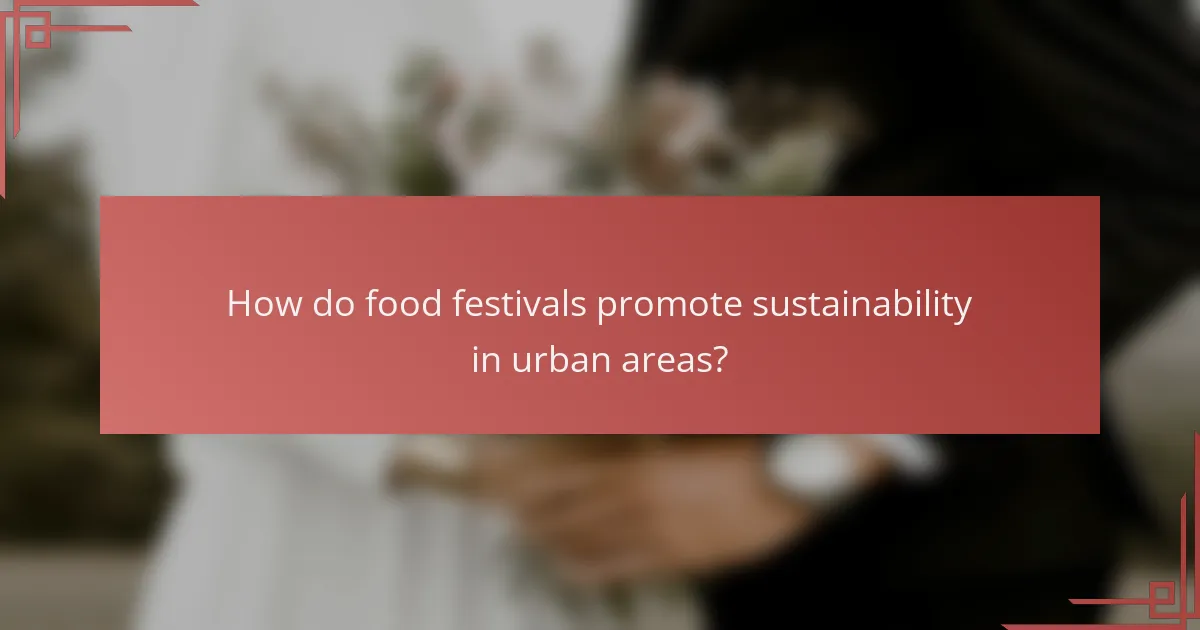
How do food festivals promote sustainability in urban areas?
Food festivals promote sustainability in urban areas by encouraging local sourcing, reducing waste, and fostering community awareness about environmental practices. These events create a platform for sustainable food practices, benefiting both the environment and local economies.
Reduction of food waste
Food festivals often implement strategies to minimize food waste, such as partnering with local charities to donate leftover food. This practice not only helps feed those in need but also reduces the amount of waste sent to landfills, which can contribute to greenhouse gas emissions.
Additionally, many festivals use composting systems for organic waste, turning food scraps into valuable compost for local gardens. This cycle of reuse helps maintain soil health and promotes sustainable agricultural practices.
Support for local farmers
By featuring local farmers and producers, food festivals create direct economic benefits for the community. This support helps sustain local agriculture, ensuring that small farms can thrive in an increasingly competitive market.
Local sourcing reduces transportation emissions, as food does not need to be shipped long distances. It also fosters a connection between consumers and producers, encouraging a more sustainable food culture.
Use of eco-friendly materials
Many food festivals prioritize the use of eco-friendly materials, such as biodegradable utensils and recyclable containers. This reduces the environmental impact associated with single-use plastics, which are a significant contributor to pollution.
Organizers can also encourage vendors to adopt sustainable practices by providing incentives for using green materials. This not only benefits the environment but also sets a standard for future events.
Community education on sustainability
Food festivals serve as educational platforms, providing workshops and demonstrations on sustainable practices. These activities can cover topics like composting, organic gardening, and the benefits of eating local.
By engaging the community in discussions about sustainability, festivals help raise awareness and inspire individuals to adopt more eco-friendly habits in their daily lives. This collective effort can lead to lasting changes in consumer behavior and community practices.
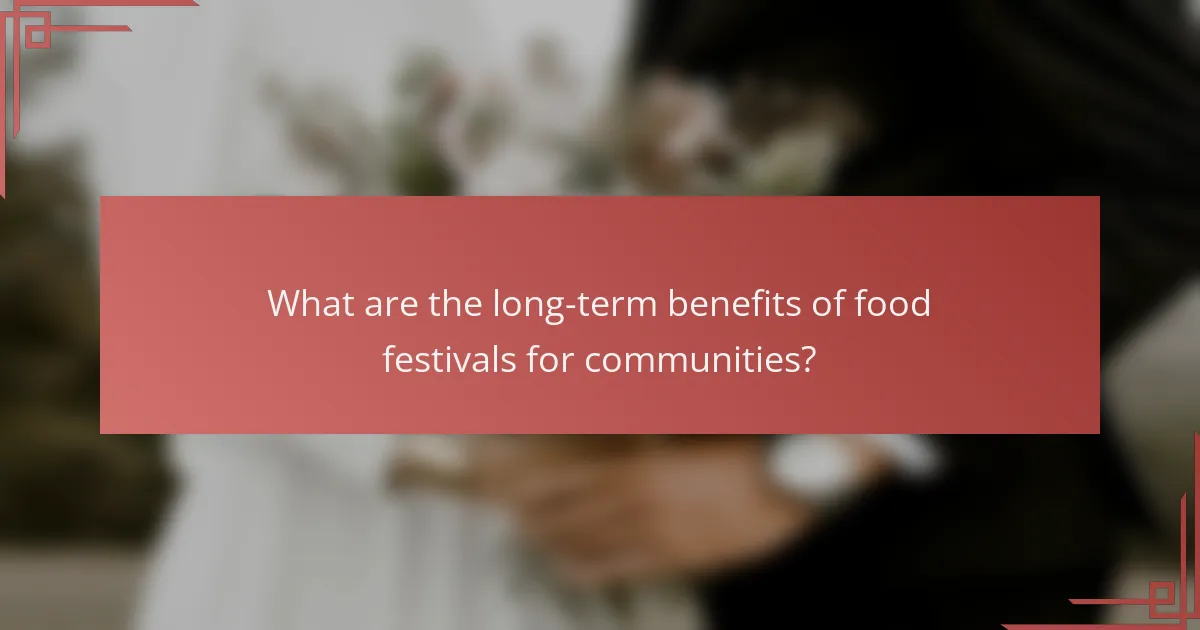
What are the long-term benefits of food festivals for communities?
Food festivals provide numerous long-term benefits for communities, including economic growth, support for local businesses, and enhanced community pride. These events create lasting connections among residents and promote sustainable practices that can positively impact the local culture and economy.
Economic growth through tourism
Food festivals attract visitors from outside the local area, boosting tourism and generating significant economic activity. This influx of tourists can lead to increased spending in local hotels, restaurants, and shops, which helps stimulate the overall economy.
Communities can capitalize on this economic growth by promoting their unique culinary offerings and cultural experiences. For example, a festival featuring local cuisine can draw food enthusiasts, resulting in higher hotel occupancy rates and increased sales for local vendors.
Strengthening local businesses
Food festivals provide a platform for local businesses to showcase their products and services, which can lead to increased visibility and customer loyalty. By participating in these events, small businesses can connect directly with potential customers and build relationships that extend beyond the festival.
Moreover, festivals often encourage collaboration among local vendors, fostering a sense of community and shared purpose. This collaboration can lead to joint marketing efforts and partnerships that benefit all involved, ultimately strengthening the local economy.
Fostering community pride
Food festivals can instill a sense of pride among community members by celebrating local culture and heritage. When residents come together to share their culinary traditions, it reinforces their identity and strengthens community bonds.
Additionally, these events often highlight local ingredients and sustainable practices, promoting environmental awareness and encouraging residents to support local farmers and producers. This focus on sustainability helps cultivate a community that values its resources and works together for a healthier future.

How do food festivals enhance community engagement?
Food festivals enhance community engagement by bringing together local residents, businesses, and organizations to celebrate culinary traditions and foster connections. These events create a vibrant atmosphere where people can share experiences, learn about local food culture, and participate in activities that strengthen community ties.
Opportunities for local collaboration
Food festivals provide a platform for local businesses, farmers, and artisans to collaborate and showcase their products. By partnering with each other, vendors can create unique offerings that attract a larger audience, such as farm-to-table meals or collaborative cooking demonstrations. This synergy not only boosts sales but also promotes a sense of unity among local stakeholders.
Additionally, festivals often involve local government and non-profits, allowing for joint initiatives that address community needs, such as food security or environmental sustainability. These collaborations can lead to long-term partnerships that benefit the community beyond the festival itself.
Promotion of cultural diversity
Food festivals celebrate cultural diversity by featuring a variety of cuisines and culinary traditions from different backgrounds. This exposure allows attendees to experience and appreciate the rich tapestry of flavors and cooking styles that exist within their community. Such events can foster understanding and respect among diverse groups, enhancing social cohesion.
Moreover, cultural performances, workshops, and storytelling sessions often accompany food offerings, providing a deeper insight into the heritage and traditions behind the dishes. This educational aspect can encourage attendees to explore and embrace cultural differences, promoting inclusivity.
Volunteer involvement
Volunteering at food festivals is a great way for community members to get involved and contribute to the event’s success. Volunteers can assist with various tasks, from setting up booths to managing activities, which fosters a sense of ownership and pride in the festival. Engaging volunteers helps to build a stronger community network, as participants often form lasting friendships through their shared experiences.
Additionally, volunteering can provide valuable skills and experiences for individuals, enhancing their resumes and community engagement. Organizations can also benefit from the fresh perspectives and energy that volunteers bring, making the festival more dynamic and enjoyable for all attendees.

What criteria should be considered when organizing a food festival?
When organizing a food festival, key criteria include location selection, vendor diversity, and environmental impact assessments. These factors ensure the festival is enjoyable, inclusive, and sustainable for the community.
Location selection
Choosing the right location for a food festival is crucial for attracting attendees and vendors. Consider accessibility, available space, and local amenities. Ideal locations often include parks, community centers, or urban areas with high foot traffic.
Evaluate the local infrastructure, such as parking and public transport, to make it easy for visitors to attend. Additionally, ensure that the site complies with local regulations regarding permits and safety standards.
Vendor diversity
Diverse vendors enhance the food festival experience by offering a wide range of cuisines and products. Aim for a mix of local restaurants, food trucks, and artisanal producers to cater to various tastes and dietary needs.
Incorporating vendors from different cultural backgrounds can enrich the festival atmosphere and promote community engagement. Consider including options for vegetarian, vegan, and gluten-free diets to ensure inclusivity.
Environmental impact assessments
Conducting an environmental impact assessment helps identify potential negative effects of the food festival on the local ecosystem. Assess factors such as waste management, energy consumption, and water usage to minimize the festival’s carbon footprint.
Implement sustainable practices like composting, recycling, and using biodegradable materials. Engage vendors in these efforts by encouraging them to adopt eco-friendly packaging and practices, which can enhance the festival’s reputation and community support.
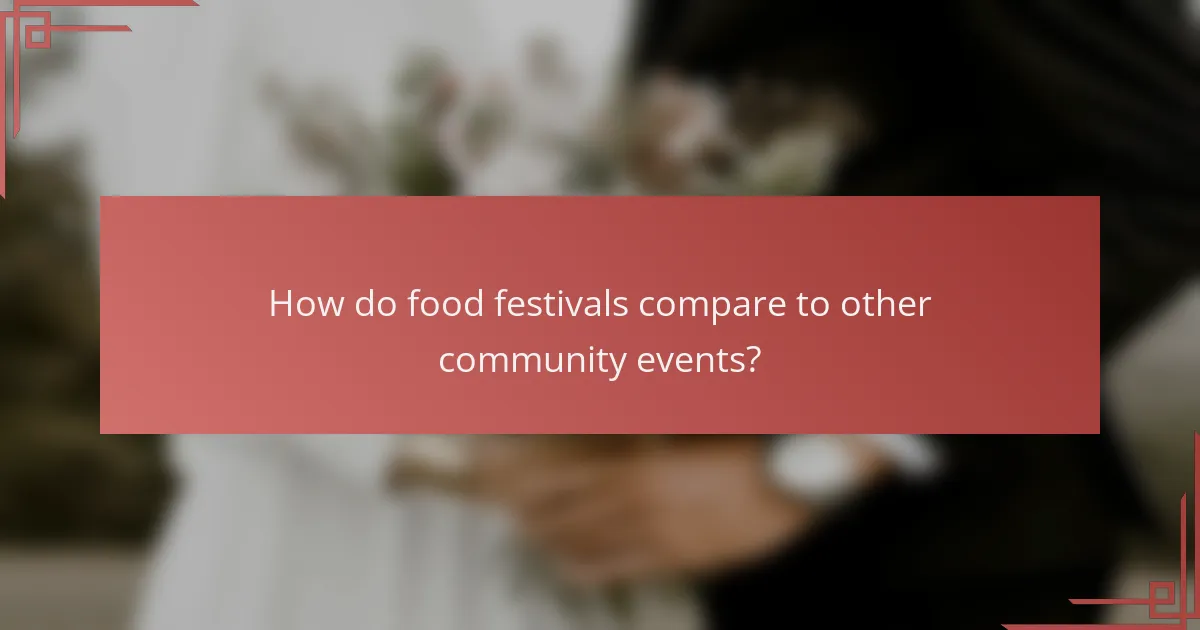
How do food festivals compare to other community events?
Food festivals stand out from other community events by focusing primarily on culinary arts, local produce, and cultural gastronomy. They foster community engagement while promoting local businesses and sustainable practices, making them unique in their contributions to social and economic dynamics.
Unique culinary experiences
Food festivals offer attendees the chance to explore diverse culinary experiences that may not be available in everyday dining. Visitors can sample a variety of dishes from local chefs, food trucks, and artisan vendors, often highlighting regional specialties and seasonal ingredients.
These events frequently feature cooking demonstrations, tastings, and workshops, allowing participants to learn about food preparation and the cultural significance behind various cuisines. This hands-on approach enhances appreciation for local food traditions and encourages sustainable eating habits.
For example, a food festival in Italy might showcase regional pasta-making techniques, while a festival in the United States could highlight barbecue styles from different states. Such experiences deepen community ties and promote local culinary talent.

